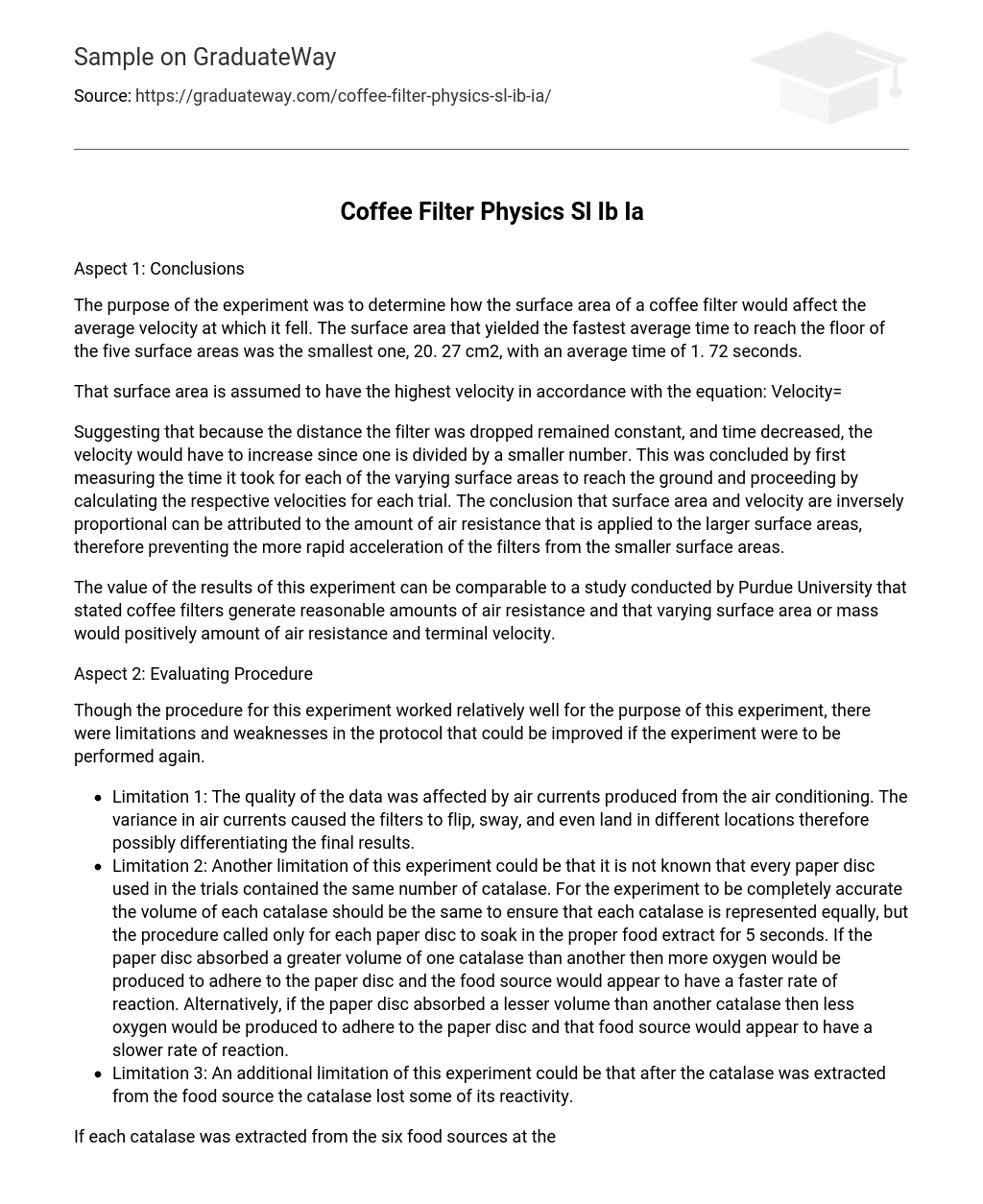Aspect 1: Conclusions
The purpose of the experiment was to determine how the surface area of a coffee filter would affect the average velocity at which it fell. The surface area that yielded the fastest average time to reach the floor of the five surface areas was the smallest one, 20. 27 cm2, with an average time of 1. 72 seconds.
That surface area is assumed to have the highest velocity in accordance with the equation: Velocity=
Suggesting that because the distance the filter was dropped remained constant, and time decreased, the velocity would have to increase since one is divided by a smaller number. This was concluded by first measuring the time it took for each of the varying surface areas to reach the ground and proceeding by calculating the respective velocities for each trial. The conclusion that surface area and velocity are inversely proportional can be attributed to the amount of air resistance that is applied to the larger surface areas, therefore preventing the more rapid acceleration of the filters from the smaller surface areas.
The value of the results of this experiment can be comparable to a study conducted by Purdue University that stated coffee filters generate reasonable amounts of air resistance and that varying surface area or mass would positively amount of air resistance and terminal velocity.
Aspect 2: Evaluating Procedure
Though the procedure for this experiment worked relatively well for the purpose of this experiment, there were limitations and weaknesses in the protocol that could be improved if the experiment were to be performed again.
- Limitation 1: The quality of the data was affected by air currents produced from the air conditioning. The variance in air currents caused the filters to flip, sway, and even land in different locations therefore possibly differentiating the final results.
- Limitation 2: Another limitation of this experiment could be that it is not known that every paper disc used in the trials contained the same number of catalase. For the experiment to be completely accurate the volume of each catalase should be the same to ensure that each catalase is represented equally, but the procedure called only for each paper disc to soak in the proper food extract for 5 seconds. If the paper disc absorbed a greater volume of one catalase than another then more oxygen would be produced to adhere to the paper disc and the food source would appear to have a faster rate of reaction. Alternatively, if the paper disc absorbed a lesser volume than another catalase then less oxygen would be produced to adhere to the paper disc and that food source would appear to have a slower rate of reaction.
- Limitation 3: An additional limitation of this experiment could be that after the catalase was extracted from the food source the catalase lost some of its reactivity.
If each catalase was extracted from the six food sources at the same time in preparation for the experiment some of the catalase were exposed to the open for longer which could have caused the concentration of catalase to decrease.
Aspect 3: Revisions
If this experiment were to be performed again changes to the procedure in order to decrease the limitations and weaknesses in the protocol should be made.
- Limitation 1: An area devoid of air currents should be used to avoid the discrepancies that were given because of possible air currents.
- Limitation 2: Equal representation of all catalase of the food source is imperative for the accuracy of the rate of reaction of the food sources in this experiment.
To ensure the equal representation of the catalase of each food source another control should be added to the procedure protocol to determine the volume of liquid that the paper disc is able to soak up. This can be done by using a micropipette to measure a small volume of each catalase onto the disc before performing the trials. This will determine the volume of fluid that the paper disk is able to soak up without dripping.
This method will ensure that each paper disc is completely saturated versus the original protocol of dipping the paper disc into the catalase for 5 seconds which allowed for the paper disc either to soak up too much or not enough catalase.
- Limitation 3: Enzymes are proteins and if the enzyme loses its shape it can no longer bind with the protein than it is considered to be denatured. Enzymes can become denatured for a number of reasons including exceeding optimum temperature for the enzyme to react and too high or low pH.
If enzymes some become denatured and can no longer bind with their substrates then the rate of reaction will be slower then if the enzymes had optimal conditions. Also, mentioned in the study conducted by Sharon B. Miller the catalase must be “fresh” and if the food extract is sitting for too long then it allows time for the catalase to lose freshness. If this experiment were to be performed again once the catalase is extracted from the foot source the catalase should be placed on ice to keep the enzymes from denaturing and losing reactivity.
Placing the enzymes on ice will also slow down the overall rate of reaction which will make the reactions more observable so that more accurate data can be taken.





